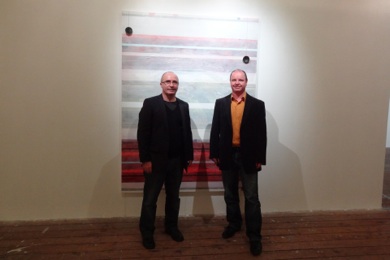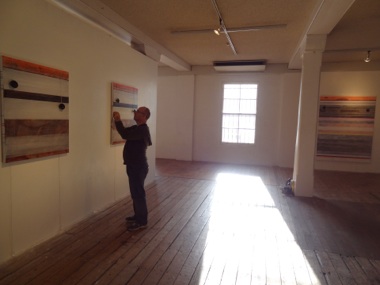This work by Daniel Mafe and Andrew Brown in 2012 is a combination of painting and digital sound into a single, large scale, immersive exhibition/installation. The work as a whole acts as an interstitial point between contrasting approaches to abstraction: the visual and aural, the digital and analogue are pushed into an alliance and each works to alter perceptions of the other.

To walk into the exhibition Affecting Interference is to be confronted in the first instance with what looks to all intents and purposes as a pure painting
show. But after the briefest moment of immersion one hears noise, an organisation of scratching, pulsing, droning abstract sounds emerging from speakers hanging over each
painting and from additional speakers vibrating the floor beneath your feet. The speakers are small and lo-fi and an attempt is made to disguise or camouflage them with or into the paintings. What does this range of interactions add up to? How do they perform as an ensemble?
This collaborative project by Daniel Mafe and Andrew Brown—one of a number in they have been involved in together—conjoins painting and digital sound into a single, large scale, immersive exhibition/installation. The work as a whole acts as an interstitial point between contrasting approaches to abstraction: the visual and aural, the digital and analogue are pushed into an alliance and each works to alter perceptions of the other. For example, the paintings no longer mutely sit on the wall to be stared into or at. The sound, seemingly emanating from each work shifts the viewer’s typical visual perception and engages their aural sensibilities. This seems to make one more aware of the objects as objects—the surface of each piece is brought into scrutiny—and immerses the viewer more viscerally within the exhibition. Similarly, the sonic experience is focused and concentrated spatially by each painted piece even as the exhibition is dispersed throughout the space. The sounds and images are similar in each local but not identical, even though they may seem to be the same from casual interaction, closer attention will quickly show this is not the case.

In preparing this exhibition each artist, Daniel Mafe a visual artist and Andrew Brown a sound artist, has had to shift their usual mode of making to accommodate the other’s contribution. This was mainly done by a process of emptying whereby each was called upon to do less to the works they were contributing and to iterate the works toward a shared conception, blurring notions of individual imagination while maintaining material authorship. Emptying was necessary to enable sufficient porosity where each medium allowed the other entry to its previously gated domain. The paintings are consist of a geometrically simple yet subtle catalogue of horizontal stripes, to allow the sonic textures a chance to work on the viewer’s engagement with them. The sound remains both resolutely abstract, using noise-like textures, and at a low volume to allow the audience’s attention to wander back and forth between aspects of the works.
Apparently simple features such as painterly stripes and sonic drones and scratchy noise provide only the most superficial structure in the work. Rather these techniques create a clearing or openness from which the potentialities inherent in the work can emerge. These potentialities arise over time as details are interrogated, and as sounds and visual relationships within the exhibition become apparent. Like many audiovisual installations, this work plays with the audiences embodied presence and movement in the exhibition space for the unfolding of experience. In particular, the directionality of the high frequency sound sources are coupled with canvases to both direct and distract attention. And low frequency sounds resonate through the floor and wall structures of the exhibition to provide a subtle visceral sensation of embodiment in the work.

While our work, like many ‘noise’ artists, hopes to provide a rich texture for audiences to engage with, it does not share the common intent to assault the senses with volume or complexity as a technique to prompt sense-making, but rather it relies on subtly and superficial simplicity to intrigue and entice. The volume is reduced to force the audience to strain towards the sound much as one leans forward to catch a whispered conversation.
More details and discussion in Mafe, D., & Brown, A. R. (2012). Noise as Abstraction: Enhancing the poetic. In Proceedings of the Second International
Conference on Transdisciplinary Imaging at the Intersections between Art, Science and Culture. Melbourne, Australia: Victorian College of the Arts.
